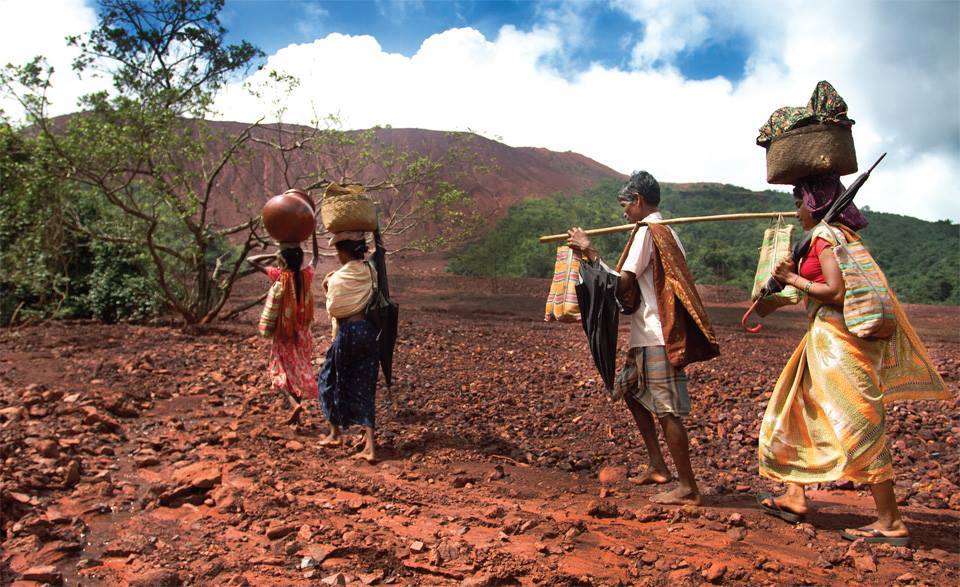Chhattisgarh, Jharkand, Orissa and Bengal, all experience these waves of migration as Adivasis desperately seek a way out of economic poverty and social insecurity

In recent years three distinct types of migration waves can be observed taking place in the Adivasi dominant states of Chhattisgarh, Jharkhand, Odisha and Bengal.
The First Wave is the migration of young Adivasi women to metropolitan cities. The reasons behind this is that is nothing in the house or village to occupy these women in a profitable or meaningful way.
After the mono-crop, which is paddy is harvested on their tiny plots of land, families find that the harvest will last only for a few months. Instead of sitting at home, idle and starving, girls and women opt to migrating to cities and towns to work as house-keepers in urban middle-class families.
They are completely unaware of the risks and dangers involved. They get in touch with some middle-men/women and take off often without even informing and getting the consent of their parents.
They land up in metropolitan cities like Delhi, Mumbai completely at the mercy and disposal of placement-agencies with no choice over future employers, or the type of work, wages, living conditions etc. they want. Their number is estimated to be around three-to-four lakhs.
The Second Wave is the seasonal migration of entire families to northern states. June to December is the monsoon-fed agricultural season. As the food produced is insufficient to feed the family for the whole year and there is no possibility of a second crop because of lack of irrigation hundreds of Jharkhandi families leave their homes and hearth, temporarily, between January to May. Only some elderly members are left to attend to the cattle. The government turns a blind eye to this annual tragedy.
The Third Wave is the recent exodus of Adivasi youth to the Southern States as casual/contract labour. Thousands of them work mostly at the construction work sites in the cities of Karnataka and Tamilnadu and cities, farms and plantations of Kerala. They go there either through contacts with persons who are already there or they are taken in batches by contractors/middle-men.
In short it is a story of the poor making the rich to live more comfortably.
How do we explain this relatively new phenomenon of thousands of Adivasis from central Indian States coming to south India?
There are two main reasons:
(i) Deepening poverty: while the Indian economy is said to be growing at the fastest rate, poverty is deepening in the Adivasi belt of central India. Blessed by nature with rich mineral wealth has now become a curse to them.
The Indian state, who is today, more and more, as far as policies and orientation is concerned, both controlled and directed by the corporate sector, has decided to excavate the mines with minerals, at all costs.
The protective constitutional provisions, laws, judicial verdicts meant to protect the Adivasi have been cast aside nd are being disregarded and safeguards violated.
Meagre cash compensation for their land is thrown at them and they are forced into an unfair surrender of home and hearth in the name of land acquisition. This is why the younger generation looks elsewhere for survival, and the sourthern States seem to offer limited chances in terms of casual/contract labour.
(ii) Increasing State repression:The Adivasis, however, are not taking this exploitative situation lying down. Resistance movements against the unjust, illegal, forcible acquisition of their jal, jangal, jamin have found an echo among people at large and some umbrella organizations vs displacement have played a significant role in turning away most companies empty handed. This includes industrial giants like Mittal, Vedanta and Posco.
This people’s resistance has been enhanced by Maoist/Naxal presence and very many Adivasi youth have joined these forces. This, in turn is fuelling renewed state repression; the figures of those incarcerated and jailed in Jharkand jails tells its own story: about 6000 men & women in its prisons accused as Maoists/Naxals. Any young man/woman in Naxal-affected areas can be labeled a maoist/naxal and can be thrown into jails.
Meanwhile, laws meant for the protection of Adivasis/ Moolvasis (tribals and indigenous peoples), such asThe Panchayats (extension to Scheduled Areas) 1996, The Forest Rights of Scheduled Castes and other traditional forest dwellers Act, 2006,are consciously and copiously not implemented. The principle seems to be “starve them, shoot them and finish them”!
It is this precarious situation that has compelled a lot of these young men to get away from this situation of insecurity — at least for a while — and try and earn something for the family. So they have gone South in a wave.
In the words of our noted historian Ramachandra Guha “The Constitution of independent India advocates equality of opportunity, where no one would be neglected. These hopes were to be falsified. For it is the Adivasis who have gained least and lost most from six decades of electoral democracy. In terms of access to education, healthcare and dignified employment, they are even worse off than the Dalits. Meanwhile, millions of Adivasis have been thrown out of their homes and forests to make way for dams, factories and mining projects intended for the producers and consumers of urban India. Thus the “exploitation and dispossession” have continued, to be answered by a fresh round of “rebellions and disorder”. It is surely no accident that the greatest gains made by the Maoists in the past decade have been in the tribal districts of central and eastern India.